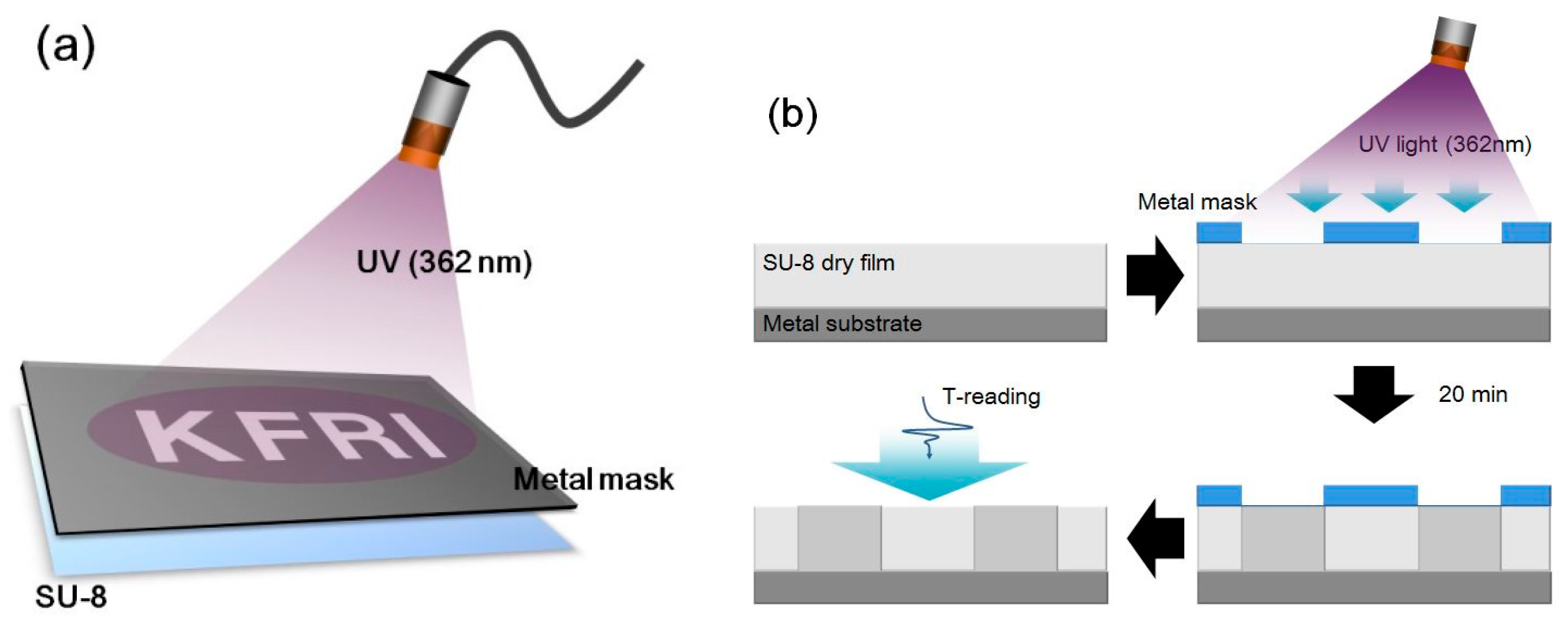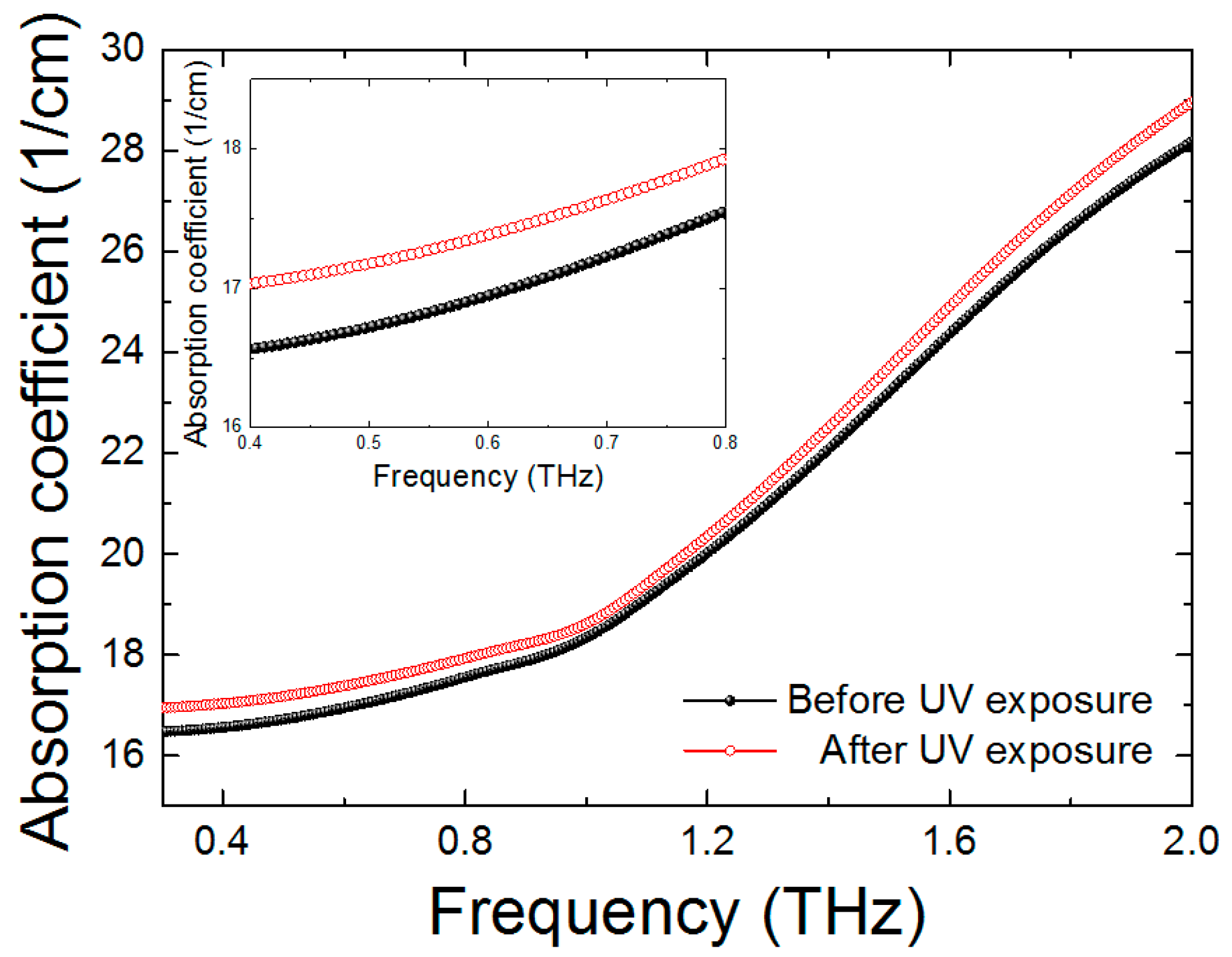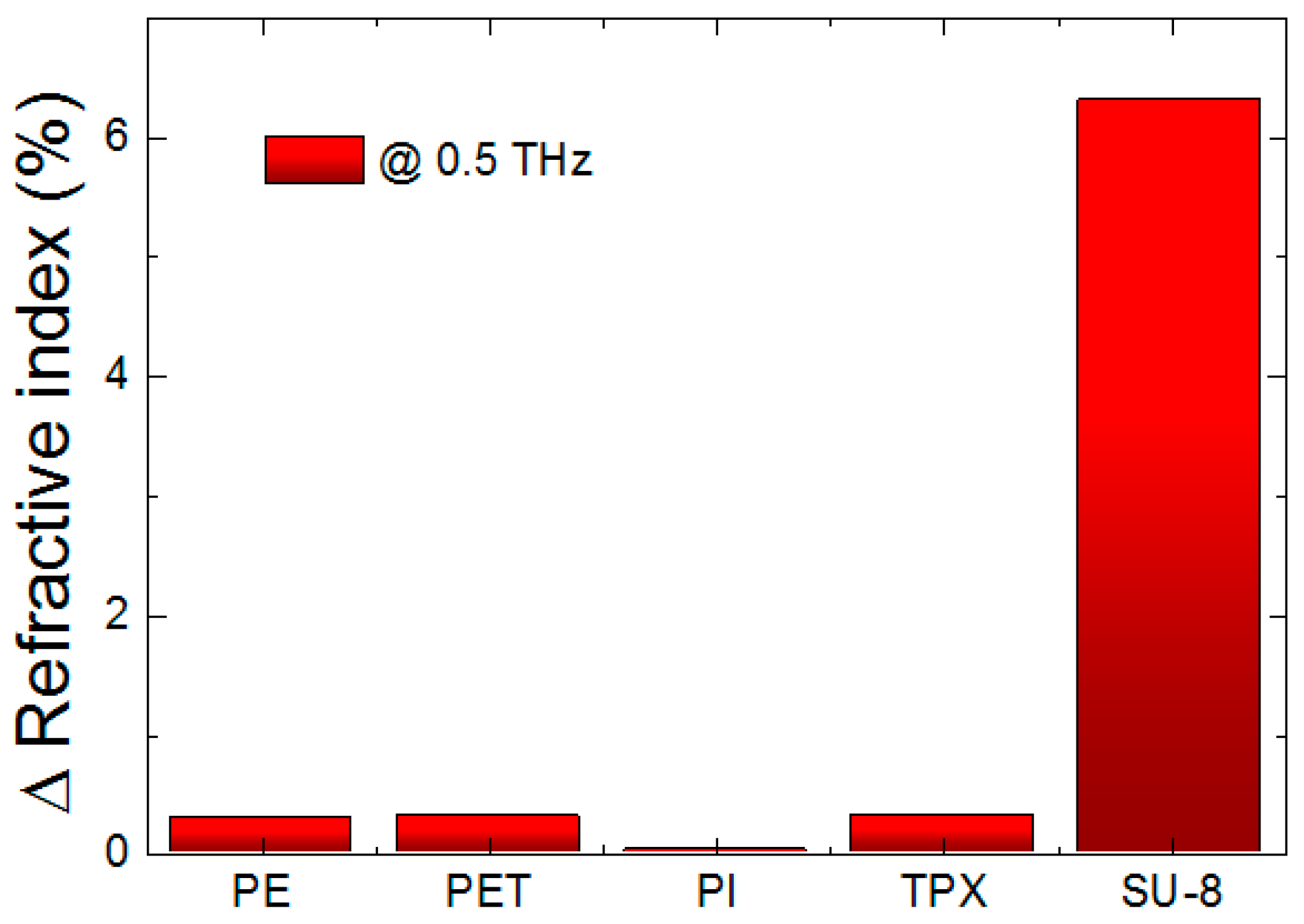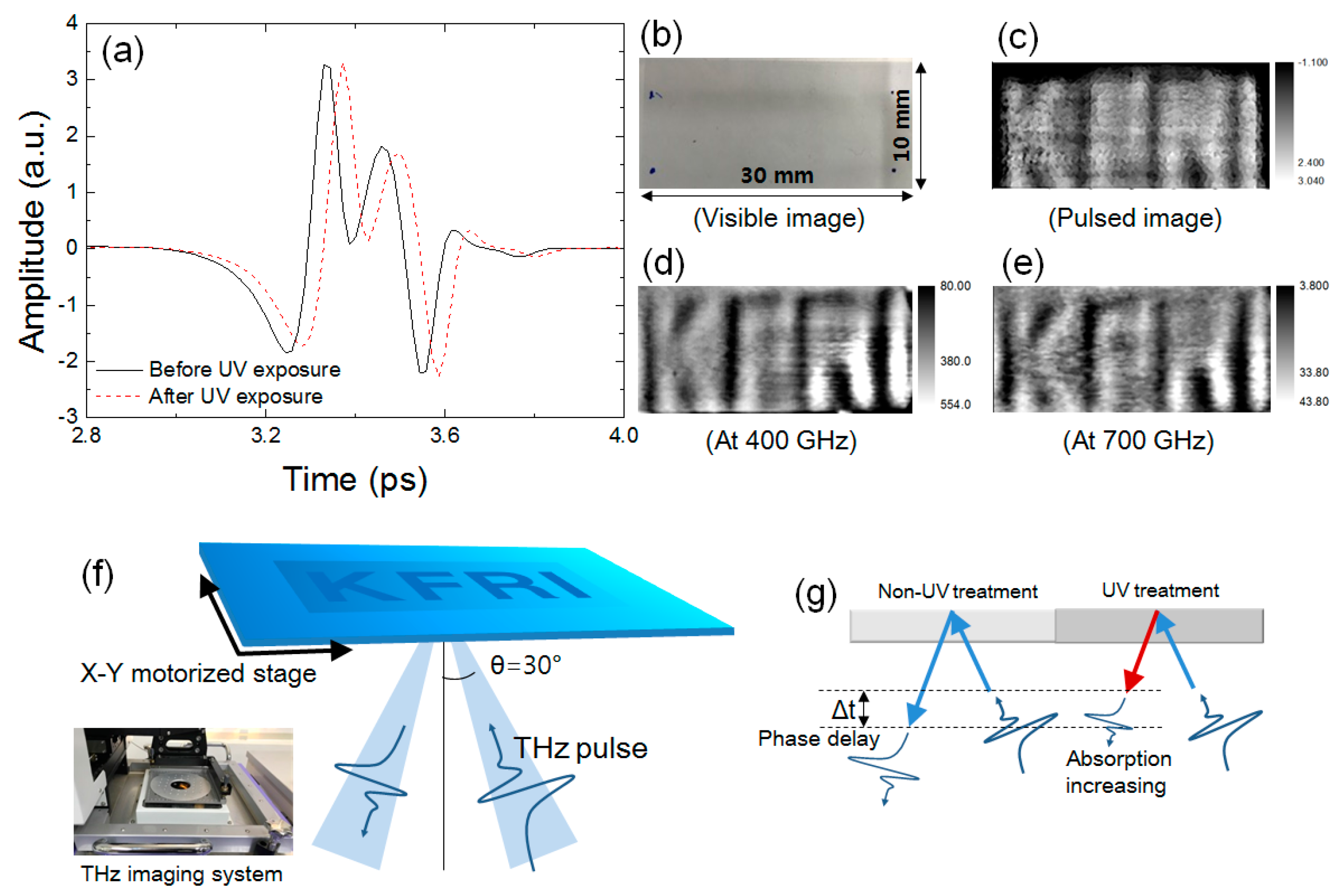Invisible Security Printing on Photoresist Polymer Readable by Terahertz Spectroscopy
Abstract
:1. Introduction
2. Materials and Experiment
2.1. THz Security Printing Material: SU-8
2.2. THz Time-Domain Spectroscopy and Reflective Imaging Measurement
2.3. THz Signal Data Processing
3. Results and Discussion
4. Conclusions
Acknowledgments
Author Contributions
Conflicts of Interest
References
- Chesak, C.E. Holographic counterfeit protection. Opt. Commun. 1995, 115, 429–436. [Google Scholar] [CrossRef]
- Janucki, J.; Owsik, J. A holographic method for document protection against counterfeit. Opt. Commun. 2003, 228, 63–69. [Google Scholar] [CrossRef]
- Aggarwal, A.K.; Kaura, S.K.; Chhachhia, D.P.; Sharma, A.K. Concealed moiré pattern encoded security holograms readable by a key hologram. Opt. Laser Technol. 2006, 38, 117–121. [Google Scholar] [CrossRef]
- Yoon, B.; Lee, J.; Park, I.S.; Jeon, S.; Lee, J.; Kim, J.M. Recent functional material based approaches to prevent and detect counterfeiting. J. Mater. Chem. C 2013, 1, 2388–2403. [Google Scholar] [CrossRef]
- Cui, Y.; Hegde, R.S.; Phang, I.Y.; Lee, H.K.; Ling, X.Y. Encoding molecular information in plasmonic nanostructures for anti-counterfeiting applications. Nanoscale 2014, 6, 282–288. [Google Scholar] [CrossRef] [PubMed]
- Huang, K.; Carulli, J.M.; Makris, Y. Counterfeit electronics: A rising threat in the semiconductor manufacturing industry. In Proceedings of the 44th IEEE International Test Conference, Anaheim, CA, USA, 6–13 September 2013. [Google Scholar]
- Deisingh, A.K. Pharmaceutical counterfeiting. Analyst 2005, 130, 271–279. [Google Scholar] [CrossRef] [PubMed]
- Lee, R.A. Micro-technology for anti-counterfeiting. Microelectron. Eng. 2000, 53, 513–516. [Google Scholar] [CrossRef]
- Zunze, H.; Hao, Z. A new digital anti-counterfeiting passport. In Proceedings of the 2010 2nd International Conference on Signal Processing Systems, Dalian, China, 5–7 July 2010. [Google Scholar] [CrossRef]
- Bae, H.J.; Bae, S.; Park, C.; Han, S.; Kim, J.; Kim, L.N.; Kim, K.; Song, S.-H.; Park, W.; Kwon, S. Biomimetic microfingerprints for anti-counterfeiting strategies. Adv. Mater. 2015, 27, 2083–2089. [Google Scholar] [CrossRef] [PubMed]
- Mills, A. Oxygen indicators and intelligent inks for packaging food. Chem. Soc. Rev. 2005, 34, 1003–1011. [Google Scholar] [CrossRef] [PubMed]
- Abargues, R.; Rodriguez-Canto, P.J.; Albert, S.; Suarez, I.; Martínez-Pastor, P. Plasmonic optical sensors printed from Ag—PVA nanoinks. J. Mater. Chem. C 2014, 2, 908–915. [Google Scholar] [CrossRef]
- Ergün, S.; Sönmez, S. Terahertz technology for military applications. J. Mil. Inf. Sci. 2015, 3, 13–16. [Google Scholar] [CrossRef]
- Federici, J.F.; Schulkin, B.; Huang, F.; Gary, D.; Barat, R.; Oliveira, F.; Zimdars, D. THz imaging and sensing for security applications—Explosives, weapons and drugs. Semicond. Sci. Technol. 2005, 20, S266. [Google Scholar] [CrossRef]
- Kemp, M.C.; Taday, P.F.; Cole, B.E.; Cluff, J.A.; Fitzgerald, A.J.; Tribe, W.R. Security applications of terahertz technology. Proc. SPIE 2003, 5070, 44–52. [Google Scholar] [CrossRef]
- Tribe, W.R.; Newnham, D.A.; Taday, P.F.; Kemp, M.C. Hidden object detection: Security applications of terahertz technology. Proc. SPIE 2004, 5354, 169. [Google Scholar] [CrossRef]
- Zhang, H.; Sfarra, S.; Saluja, K.; Peeters, J.; Fleuret, J.; Duan, Y.; Fernandes, H.; Avdelidis, N.; Ibarra-Castanedo, C.; Maldague, X. Non-destructive investigation of paintings on canvas by continuous wave terahertz imaging and flash thermography. J. Nondestruct. Eval. 2017, 36, 34. [Google Scholar] [CrossRef]
- Federici, J.; Moeller, L. Review of terahertz and subterahertz wireless communications. J. Appl. Phys. 2010, 107, 111101. [Google Scholar] [CrossRef]
- Song, Q.; Zhao, Y.; Redo-Sanchez, A.; Zhang, C.; Liu, X. Fast continuous terahertz wave imaging system for security. Opt. Commun. 2009, 282, 2019–2022. [Google Scholar] [CrossRef]
- Lorenz, H.; Despont, M.; Fahrni, M.; LaBianca, N.; Renaud, P.; Vettiger, P. SU-8: A low-cost negative resist for MEMS. J. Micromech. Microeng. 1997, 7, 121. [Google Scholar] [CrossRef]
- Shin, H.J.; Oh, S.J.; Kim, S.I.; Kim, H.W.; Son, J.-H. Conformational characteristics of β-glucan in laminarin probed by terahertz spectroscopy. Appl. Phys. Lett. 2009, 94, 111911. [Google Scholar] [CrossRef]
- Del Campo, A.; Greiner, C. SU-8: A photoresist for high-aspect-ratio and 3D submicron lithography. J. Micromech. Microeng. 2007, 17, R81–R95. [Google Scholar] [CrossRef]
- Ong, B.H.; Yuan, X.; Tjin, S.C. Adjustable refractive index modulation for a waveguide with SU-8 photoresist by dual-UV exposure lithography. Appl. Opt. 2006, 45, 8036–8039. [Google Scholar] [CrossRef] [PubMed]
- Salazar-Miranda, D.; Castillon, F.F.; Sanchez-Sanchez, J.J.; Angel-Valenzuela, J.L.; Marquez, H. Refractive index modulation of SU-8 polymer optical waveguides by means of hybrid photothermal process. Rev. Mex. Ing. Quím. 2010, 9, 85–90. [Google Scholar]
- Avila, L.F.; Nalin, M.; Cescato, L. Self diffraction holographic techniques for investigation of photosensitive materials. Proc. SPIE Hologr. Adv. Modern Trends III 2013, 8776, 87760G. [Google Scholar] [CrossRef]
- Wang, X.B.; Sun, J.; Chen, C.M.; Sun, X.Q.; Wang, F.; Zhang, D.M. Thermal UV treatment on SU-8 polymer for integrated optics. Opt. Mater. Express 2014, 4, 509–517. [Google Scholar] [CrossRef]





© 2017 by the authors. Licensee MDPI, Basel, Switzerland. This article is an open access article distributed under the terms and conditions of the Creative Commons Attribution (CC BY) license (http://creativecommons.org/licenses/by/4.0/).
Share and Cite
Shin, H.J.; Lim, M.-C.; Park, K.; Kim, S.-H.; Choi, S.-W.; Ok, G. Invisible Security Printing on Photoresist Polymer Readable by Terahertz Spectroscopy. Sensors 2017, 17, 2825. https://doi.org/10.3390/s17122825
Shin HJ, Lim M-C, Park K, Kim S-H, Choi S-W, Ok G. Invisible Security Printing on Photoresist Polymer Readable by Terahertz Spectroscopy. Sensors. 2017; 17(12):2825. https://doi.org/10.3390/s17122825
Chicago/Turabian StyleShin, Hee Jun, Min-Cheol Lim, Kisang Park, Sae-Hyung Kim, Sung-Wook Choi, and Gyeongsik Ok. 2017. "Invisible Security Printing on Photoresist Polymer Readable by Terahertz Spectroscopy" Sensors 17, no. 12: 2825. https://doi.org/10.3390/s17122825



